Research advances on electrode materials for solid oxide electrolysis cells
Hongyun Su, Duoli Wu, Chengxin Li, Chngjiu Li, Cho Zhng,*
a College of Mechanical Engineering, Yangzhou University, Yangzhou, 225127, PR China
b State Key Laboratory for Mechanical Behavior of Materials, School of Materials Science and Engineering, Xi'an Jiaotong University, Xi'an, Shaanxi, 710049, PR China
Keywords:Solid oxide electrolysis cell Oxygen electrode Hydrogen electrode Perovskite oxide
A B S T R A C T Solid oxide electrolytic cell (SOEC) is an energy conversion device that transfers electrical energy into chemical energy.It has garnered significant attention due to its high efficiency and thick current density.The oxygen evolution reaction(OER)and the hydrogen evolution reaction(HER)are two crucial half-reactions of SOEC,while both require excellent electrochemical performance under high-temperature and high-humidity conditions.Therefore,high catalytic activity and good stability of electrode materials are crucial for the practical application of SOEC.The perovskite structure of the oxygen electrodes has outstanding OER activity,while metal ceramic and metal oxide hydrogen electrodes possess good redox properties.This article firstly demonstrates the influence of the physical and electrochemical properties of electrode materials on the performance of SOEC, then illustrates the optimization strategies for electrode materials to improve electrolysis efficiency and extend service life.Finally, the research priorities for the future development of electrode material are summarized.
1.Introduction
The forms of energy consumed by humans in daily life and industrial production, from coal to oil to natural gas, reflect a trend of decarbonization and hydrogenation in the carriers of energy used [1].As an energy carrier, hydrogen can meet the energy demand of global development and also reduce carbon emissions,which has a crucial role in shaping the future direction.
Currently,coal-based hydrogen production stands as the predominant method for hydrogen production in China.However, it faces technical barriers such as complex processes and inability to achieve carbon-free emissions.Moreover, the gas impurities produced by hydrogen production from fossil fuels are high, and further purification increases production costs.Therefore, under the background of the “dual-carbon”strategy, the development of renewable energy electrolysis hydrogen production technology is an important measure for China to achieve green and low-carbon energy transformation [1], which mainly uses electric energy to causes an electrochemical reaction in water molecules,thereby obtaining the required H2and O2[2].There are also differences in water electrolysis for hydrogen production, which can be mainly classified into the following three types of electrolysis technology:Alkaline water electrolysis (AWE), Proton exchange, Membrane water electrolysis (PEM) and Solid oxide electrolysis (SOEC) [3].The comparison of these three types is shown in Table 1.AWE has the advantages of stable and safe technology, relatively low cost and easy operation.Furthermore, AWE is currently the mainstream method of electrolytic hydrogen production in China.However,it also has the disadvantage of low electrolysis efficiency.PEM has the advantages of safety, environmental protection, large reaction area, ideal conversion efficiency,compact and flexible structure and low intra-cell resistance, but it is relatively expensive.In comparison to the previous two,SOEC has edges in efficiency and current density, and can save more than 30% of electricity under the same operating conditions.In addition, SOEC requires more heat to heat the water during operation, and scenarios such as nuclear power plants and steel metallurgy generate a large amount of waste heat, which has a high degree of compatibility with SOEC which requires high temperatures.However, high temperature also constrains the selection of materials.SOEC is undoubtedly a solution to the shortcoming of both AWE and PEM electrolysis, as the technology is not yet fully mature, while continuous optimization in future practice may trigger the next hot spot in the field of hydrogen energy[4].
The operating temperature of SOEC is generally from 500 to 1000°C.At high temperatures,the reaction gas undergoes a reduction reaction to generate H2and O2-at the hydrogen electrode [7], while the chemical reaction at the oxygen electrode mainly oxidizes O2-to O2.Therefore,to ensure the efficiency of the SOEC, it is required that the electrode materials have good chemical stability and electronic conductivity under high temperature and high oxidation/reduction atmosphere[8].
As a promising hydrogen production technology, SOEC has significant implications for China's efforts to build a low-carbon, safe, and efficient energy system under the “dual carbon” goals.Electrode materials are an important factor affecting the performance of SOEC.In this article, different electrode materials will be described in depth and the optimal regulation strategy will be introduced.The review structure is shown in Fig.1.
2.Oxygen electrode materials
SOEC oxygen electrode materials mainly involve perovskite-type oxides [9], which are important in solid-state and materials chemistry[10,11].Initially, perovskite oxides containing only CaTiO3were studied,and then the research extended to perovskite-type metal oxides with cation ordering similar to that of CaTiO3.Perovskite-type oxides can be classified into single perovskite-type oxides, double perovskite-type oxides and Ruddlesden-Popper(RP, An+1BnO3n+1).
2.1.Single perovskite-type
Single perovskite oxide is the most classic in the perovskite oxide family with a chemical formula of ABO3.The ion size of element A is larger than that of the B cation.The A-site elements are mainly selected from alkali metals and rare earth metals, while the B-site elements are occupied by transition metal ions.Single perovskites can be mainly divided into Lanthanum Mn-doped perovskite, Lanthanum Fe-doped perovskite, Lanthanum Co-doped perovskite, and multi-metal doped perovskite.
2.1.1.Lanthanum Mn-doped perovskite
LSM(La0.8Sr0.2MnO3)is one of the early studied SOEC electrode materials,which exhibits good catalytic activity.Due to the A-site doping of Sr2+in LSM,the valence state of Mn is changed,resulting in excellent conductivity.The oxygen evolution reaction (OER) is confined to the electrode/electrolyte interface, leading to a significant increase in oxygen partial pressure, which causes the oxygen electrode to delaminate and peel off, ultimately leading to a marked deterioration in SOEC performance.To address this issue,YSZ and LSM are typically mechanically mixed to form a hybrid electrode, which improves the electrode's ionic conductivity.YSZ and LSM also have closely matched thermal expansion coefficients (TEC), effectively alleviating electrode delamination and peeling issues.Therefore, the LSM-YSZ hybrid electrode is commonly employed as an oxygen electrode.In the electrode preparation process,ceramic technology is usually used to mix with organic additives to grind the slurry,which is applied onto the surface of the electrolyte to form an oxygen electrode.However,this traditional method is difficult to obtain a uniform LSM-YSZ electrode [9].To further investigate, Yang et al.[12]used a nitrate-glycerol combustion method to prepare a porous network structure LSM-YSZ oxygen electrode.By optimizing the microstructure of the electrode to increase its electrochemical active surface area, it was found that the number of LSM/YSZ/gas triple-phase boundary sites for oxygen ion oxidation in this structure oxygen electrode was proportional to its reaction rate,improving the reaction rate.
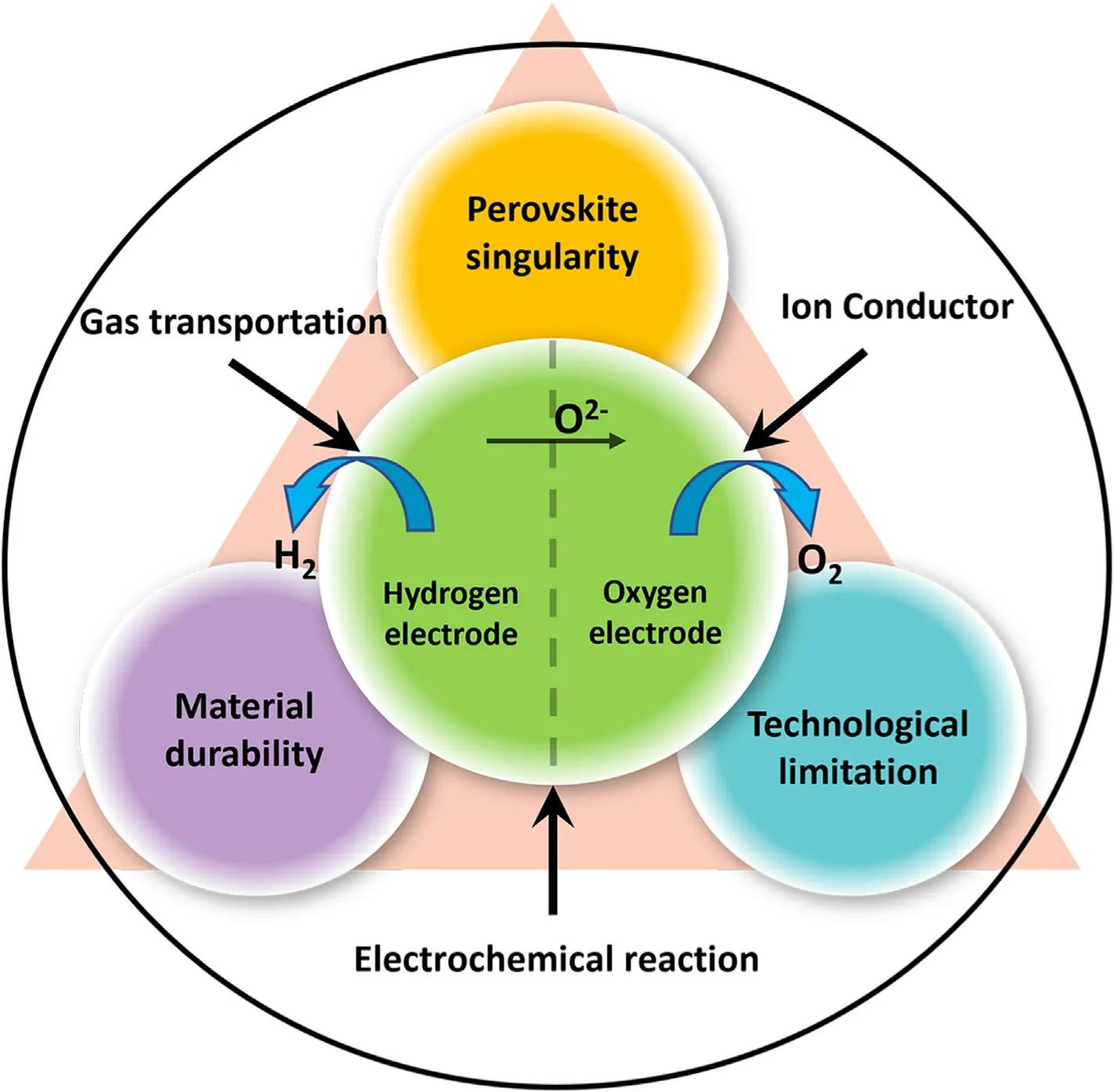
Fig.1.Drawbacks of solid oxide electrolysis cells and the strategies for developing efficient electrode materials.
2.1.2.Lanthanum Fe-doped perovskite
Compared with Lanthanum Mn-doped perovskite, Lanthanum Fedoped perovskite has higher oxygen ion conductivity.Due to its different oxidation states and spin states,Fe can provide higher catalytic activity[13].
Kong et al.[14] utilized the sol-gel auto-combustion method to synthesize La0.8Sr0.2FeO3and La0.8Sr0.2MnO3perovskites, and set up LSF20-YSZ and LSM20-YSZ composite electrodes on YSZ electrolyte discs to compare their electrochemical performance and thermal cycle stability[14,15].The microstructure and porosity of electrodes have a significant impact on their performance[14].Examining the cross-section images of the electrolyte/electrode (Fig.2a and c), it can be revealed that the LSM20-YSZ oxygen electrode exhibits a smaller grain size, while LSF20-YSZ demonstrates relatively higher porosity than LSM20-YSZ.Furthermore, from the enlarged images of the electrode bulk (Fig.2b and d),it can be seen that the adhesion between LSM20 particles and YSZ ceramic framework is relatively loose,while the contact between LSF20 particles and YSZ ceramic framework is tighter.These results indicate a good distribution of the two phases in both types of oxygen electrodes,with YSZ grains interconnected [14].During the experiments, Kong cooled both composites to room temperature and repeated the electrochemical tests after the initial electrochemical tests.A preliminary assessment of stability was made based on the differences between the two experiments [14].The analysis by the EIS test method showed that the polarization resistance (Rp) of LSM20-YSZ is higher than that of LSF20-YSZ and after thermal cycling [16].In addition, the ohmic resistance(Rs)slightly increases after thermal cycling,which may be caused by the expansion difference of the material during thermal cycling[17].Therefore, the electrochemical test results indicate that LSF20-YSZ demonstrates superior electrocatalytic performance compared to LSM20-YSZ and is more suitable for use as oxygen electrodes in SOEC applications.
2.1.3.Lanthanum Co-doped perovskite
Lanthanum Co-doped perovskite is the more common oxygen electrode material for SOEC [18], while the Co4+/Co3+in LSC can productively decrease the polarization impedance [19].Compared with LSM,LSC exhibits higher ionic and electronic conductivity and Co shows excellent catalytic activity for oxygen in alkaline electrolytes relative to other elements[20].However,LSC has the disadvantage of having a high thermal expansion coefficient.Studies have indicated that adding Ni to the B-site of LSC can reduce its thermal expansion coefficient[19],and Fe can be partially substituted for Co at the B-site of LSC to reduce its expansion coefficient while matching with some of the electrolytes[21].Although the catalytic performance of Co ions is superior to that of Fe ions,leading to a decrease in conductivity with the accession of Fe ions[22], it is more meaningful from a practical perspective[20].
To explore better performance materials based on LSC, Tong et al.[23] infiltrated LSC precursor solution into a (gadolinium-doped ceria)CGO scaffold to prepare nanostructured LSC-CGO oxygen electrodes.CGO is compatible with most perovskite materials and has higher ion conductivity than YSZ, so CGO scaffold was used instead of YSZ.The results of EIS testing showed that the LSC-CGO oxygen electrode exhibited superior activity for both Oxygen Reduction Reaction (ORR)and OER[23].
In addition,the crystal plane and electronic configuration of Co-based perovskites are also closely related to their electrolytic water activity[24,25].Zhou et al.[24]extensively studied the association between the eg orbital filled state of LaCoO3(LCO) and OER.As a stable and active water-splitting catalyst, LCO was prepared with LCO (110) and LCO(111) lattice orientations using a unique molten salt method (MSM) to enable the spin state of Co center to transition from the low-spin state of LCO(111)to the high-spin state of LCO(110)[24].The dramatic change in electronic structure enhanced charge exchange, resulting in better OER activity of LCO(110).This study provides a novel perspective on the correlation between electronic structure and electrocatalysis.
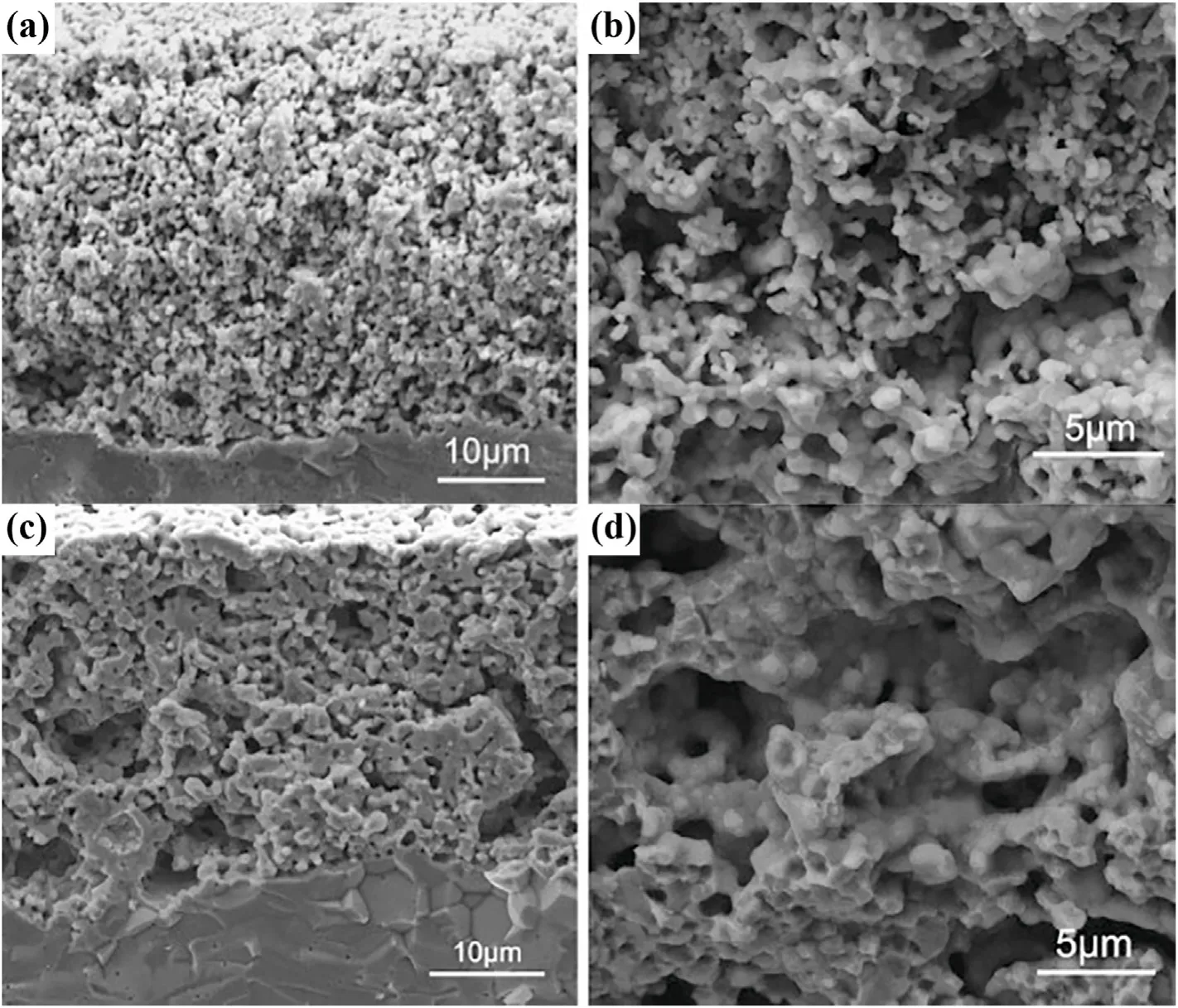
Fig.2.SEM of (a, b) LSM20-YSZ and (c, d) LSF20-YSZ Oxygen electrode [14].
2.1.4.Multi-metal doped perovskite
Among a variety of metal-doped oxygen electrode materials,the most studied is Fe-Co-based doped perovskite oxygen electrode material,which is favorable to promoting oxygen exchange[26].
As an electrode material representing mixed ionic and electronic conductivity, LSCF demonstrates outstanding catalytic activity in addition to its high conductivity.Its electrochemical performance is approximately ten times superior to that of LSM,making it a highly promising electrode material [27].LSCF is usually obtained using the traditional sol-gel strategy,which has the advantages of simplicity,and facile control for the reaction process [28].However, the material produced by this strategy is in block form, and the catalytic properties cannot be fully demonstrated.In this regard, Xu et al.[29] demonstrated an effective sol-gel strategy for the synthesis of layered LSCF using PVP as a chelating agent.Compared to the block-shaped LSCF synthesized by the traditional sol-gel strategy, layered LSCF has a higher concrete surface area and porosity,thereby improving its catalytic activity and stability.LSCF will show surface segregation of Sr elements under long-term operation,and Sr will be enriched on the LSCF surface to form insulating phases such as SrO and SrCo3, which reduces the reactivity of the oxygen electrode.Jiang et al.[30] found that the Sr segregation phenomenon in LSCF electrode can be effectively suppressed by directly placing the LSCF oxygen electrode into YSZ electrolyte at low temperatures [31].However,the activity of the electrode is dramatically diminished at lower temperatures.Park et al.[32] prepared a new LSCF composite oxygen electrode combining Gd and Nd double-doped cerium (GNDC) by a citrate-nitrate self-combustion process and compared it with the LSCF-GDC electrode with outstanding performance.Due to the exceptional oxygen ion transport properties of GNDC, the electrode demonstrated a remarkable current density of 1174 mAcm-2@1.3 V for SOEC at 750°C,and its performance exceeded that of the LSCF-GDC electrode by over 60%across all tested temperatures.
The oxygen ion conductivity of BSCF(Ba0.5Sr0.5Co0.6Fe0.2O3-δ) is superior to that of LSM-YSZ and LSCF, and It exhibits favorable phase reversibility and structural stability.Therefore,BSCF was first applied to oxygen permeation membranes [33,34].Kim-Lohsoontorn et al.[35]examined the electrochemical properties of BSCF and LSM-YSZ for SOEC.At a temperature of 1123 K and with an H2O/H2ratio of 70/30, BSCF exhibited higher efficiency than LSM-YSZ, and the discrepancy in hydrogen production rate increased with increasing voltage[33,35].
Based on BSCF, Shoroshi Dey et al.[36] synthesized BSCF-6482 mixed ionic-electronic conductive (MIEC) powder using a citric acid-nitric acid solution combustion strategy with Pechini as the raw material.The phase-pure cubic BSCF-6482 perovskite was obtained by calcination at 1000°C.The transmission electron microscopy (TEM)image, as shown in Fig.3a, reveals the characteristic of nanocrystalline structure in the synthesized powder [37].The interplanar spacing of crystal lattice planes, calculated using high-resolution transmission electron microscopy (HRTEM), was found to exhibit a strong resemblance to the reported cubic perovskite structure of the BSCF family.The HRTEM image (Fig.3b) of the BSCF-6482 material was also found to exhibit a high degree of lattice plane interpenetration.As shown in Fig.3c, the Fast Fourier Transform (FFT) pattern also confirmed this observation.This highly ordered lattice plane interpenetration induces crystal strain, making it potentially effective for electrocatalytic applications.Compared with BSCF-5582, LSCF-6482, and the traditional electrode LSM.At a working temperature of 800°C and a voltage of 1.3 V,the hydrogen production flux of the BSCF-6482 oxygen electrode was 0.57Nl/cm2/h, which was higher in efficiency than that of BSCF-5582(0.35Nl/cm2/h), LSCF-6482 (0.28Nl/cm2/h), and the traditional electrode LSM(0.23Nl/cm2/h).This also indicates that the microstructure is closely related to the superior reactivity of the BSCF-6482 electrode[36].
In order to gain a more intuitive understanding of the characteristics of the perovskite materials mentioned above, Table 2 compares the electrochemical properties of different doped types of perovskites.
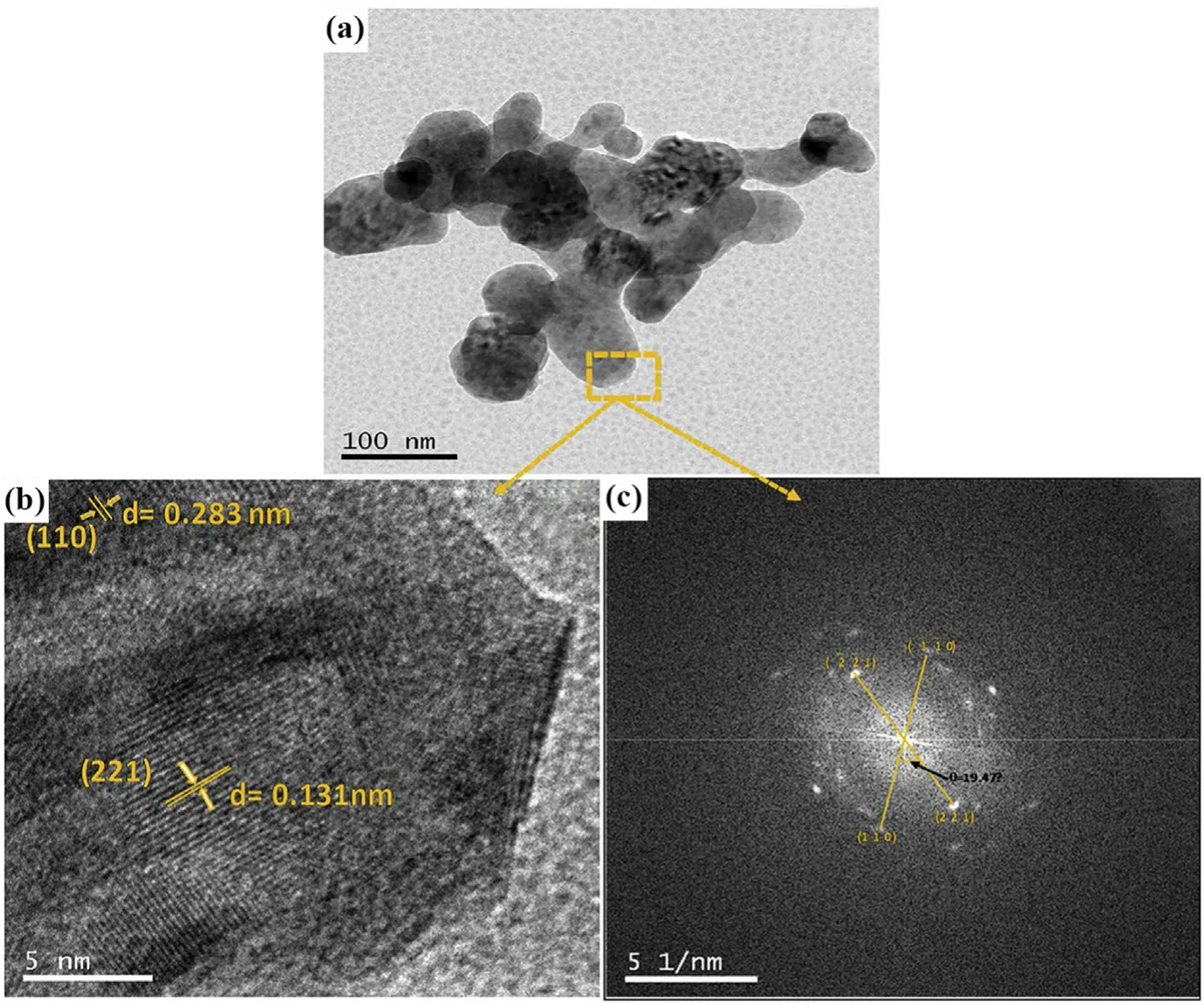
Fig.3.(a) TEM image of combustion synthesized BSCF-6482, (b) HRTEM and (c) FFT pattern of the BSCF-6482 powders [36].
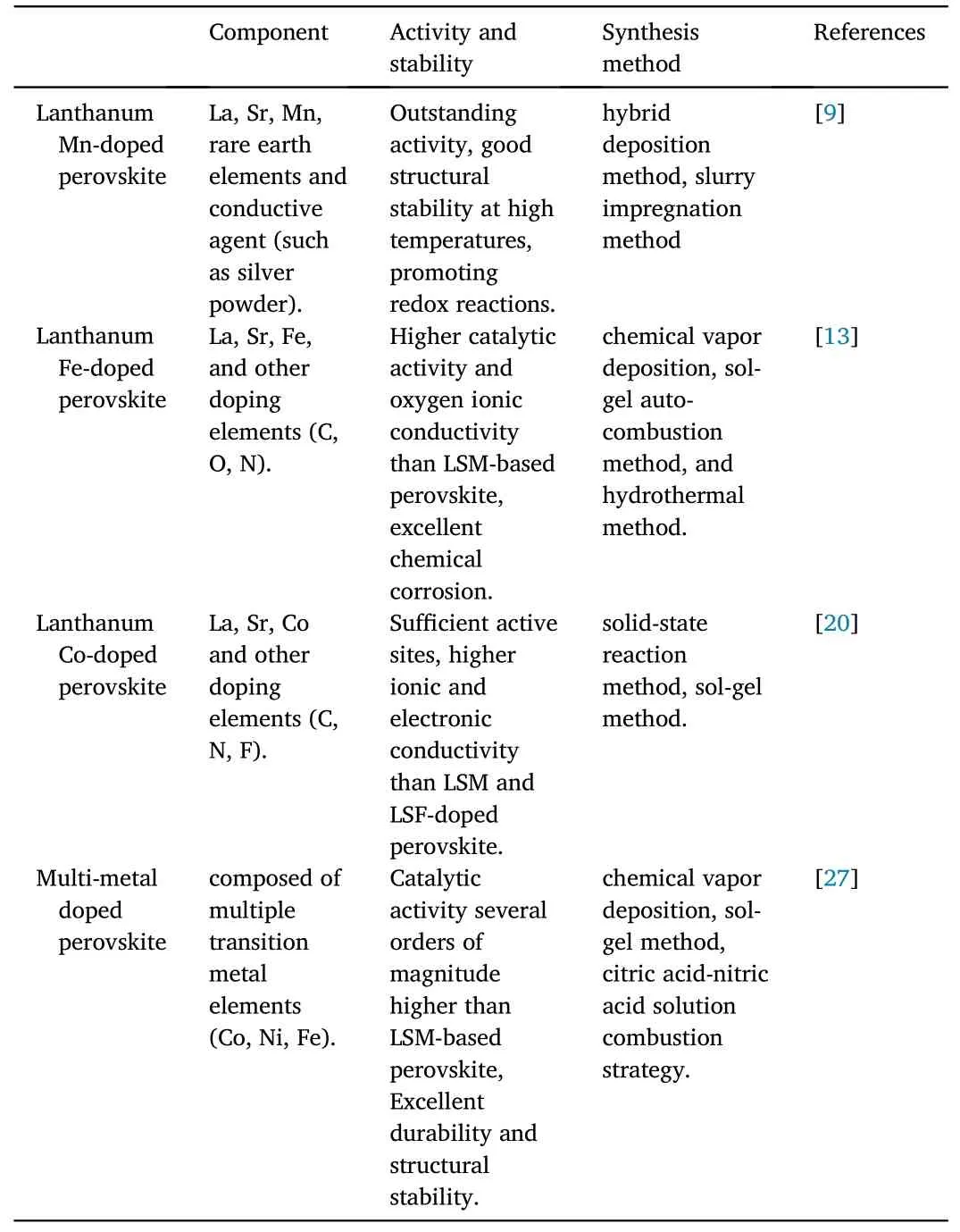
Table 2 The electrochemical properties of different doped types of perovskites.
2.2.Double perovskite oxide type
Perovskite oxides with a double perovskite structure are derived from single perovskite oxides with the chemical formula AA′BB′O6[38].Depending on the structure of the elements at the A and B sites, which can be classified into A-site modified double perovskite structures and B-site modified double perovskite structures [39].
As B and B′are the same element, an A-site modified double perovskite structure is displayed [38], which can be defined as AA′B2O6.For A-site modified double perovskite,A is usually a lanthanide element with a relatively small radius,such as Pr,Sm,etc.,A′is an alkaline earth metal Ba with a larger radius, and B is an excess metal element with different valence states,such as Fe,Mn,Co,etc.[40].
When A and A′are the same element, it is called B-site modified double perovskite structure [41], which is A2BB′O6.In this structure,A-site is an alkaline earth metal or a rare earth element with a larger radius,while B-site is a transition metal element with a lower oxidation state (Fe, Co, etc.), and B′-site is a transition metal element with a superior oxidation state,such as Mo,Nb,etc.[38].
2.2.1.A-site modified
The structural stability of A-site modified double perovskite is intimately associated with its B-site element,while Mn or Fe maintains good stability during operation.LnBaMn2O5+δis a common double perovskite oxygen electrode material.[42], Ln mainly refers to the smaller radius lanthanide elements, such as Gd, Nd, Sm, Pr, which can enhance the catalytic properties by increasing the concentration of oxygen vacancies.PrBaMn2O5+δ(PBMO)is a layered perovskite oxide with excellent mixed ion conductivity, electronic conductivity, and significant OER activity and stability[43].The layered perovskite structure of PBMO accommodates mixed transition metal cations (Mn4+/Mn3+/Mn2+), which contribute to outstanding conductivity and a significant concentration of oxygen vacancies.This facilitates the rapid diffusion of oxygen ions[44].Above all, Sun et al.[45] prepared Mo-doped PBMO using a modified sol-gel strategy.In the X-ray diffraction(XRD),H2-TPR,and thermogravimetric analysis(TGA)analysis results of the surface[45],it was found that Mo promotes the catalytic activity of the reaction, and high-temperature treatment causes phase transformation to a single cubic phase and multiple oxygen states of Mo, which promotes oxygen diffusion and makes it a candidate material for oxygen electrodes [45,46].
2.2.2.B-site modified
For B-site modified double perovskite oxides, the electrochemical properties are related to the transition metal elements on both B and B′sites.The element on the B site is a 3 d transition metal with variable valence (Mn, Co, etc.), while Mo is often chosen for the B′site, and the resulting material exhibits good conductivity and catalytic properties[47].For the A-site element,usually,an appropriate radius alkaline earth metal such as Sr is selected [48], so the research on B-site modified double perovskite oxygen electrode materials mostly uses Sr2MMoO6as the substrate [49] (M is mainly a low-valence metal element).The commonly used oxygen electrode material is Sr2Fe2-yMoyO6-δ(SFM),which has suitable electronic conductivity, excellent catalytic activity,and low cost, attracting attention [50].However, the electrochemical properties of SFM itself are poor and doping is needed to improve its electrochemical properties.Adding Co to the B site of SFM can improve its catalytic activity [51].Furthermore, doping on the A site can also enhance the property of electrodes.For example,doping K+on the A site has the characteristics of high alkalinity and large ion radius,which can reduce the formation of oxygen vacancies and enhance the efficiency of the reaction[52].
2.3.Ruddlesden-Popper type
Ruddlesden-Popper (R-P) structure materials [53] have efficient catalytic properties towards O2.In comparison to other materials, the oxide ion conductivity of R-P materials is at least one order of magnitude superior to conventional chalcogenide materials [54], mainly because the R-P structure can accommodate excess cations.The R-P structure is constituted by alternating perovskite blocks and rock crystal layers,and the perovskite blocks increase in quantity as the n value increases[55].
For R-P type materials, La2NiO4+δ(LNO) is the most extensively studied [54], which has lower polarization resistance (RP) and higher current density, and its electrochemical performance and stability are superior to LSCF oxygen electrode materials[56].In addition,LNO has a unique crystal structure and better oxygen surface exchange properties[57,58].Studies have also shown that La2NiO4+δhas a good thermal expansion coefficient matching with commonly used electrolyte materials such as YSZ and GDC [59].However, LNO may experience phase formation or structural degradation during long-term operation,leading to degradation.To address this issue, some new oxygen electrode materials can be prepared by A-Site or B-site doping techniques[60].Li et al.[59] found that doping Sr into LNO to prepare La1.5Sr0.5NiO4+δcan increase its oxygen surface coefficient[61],thereby improving the stability of RP-type oxides and alleviating degradation phenomena.
A wide variety of chalcogenide-type oxides are available with different electrochemical properties,and the properties of the oxides are summarized in Table 3.
3.Hydrogen electrode material
The hydrogen electrode is the site where the fuel gas is generated as well as the channel for electron conduction [62], In terms of material selection, it tends to favor the electrocatalytic property of the chosen materials, while also requiring structural stability in complex operating environments (high temperature, high humidity, etc.).Currently,hydrogen electrode materials can be mainly divided into metal ceramic hydrogen electrodes and metal oxide hydrogen electrodes.
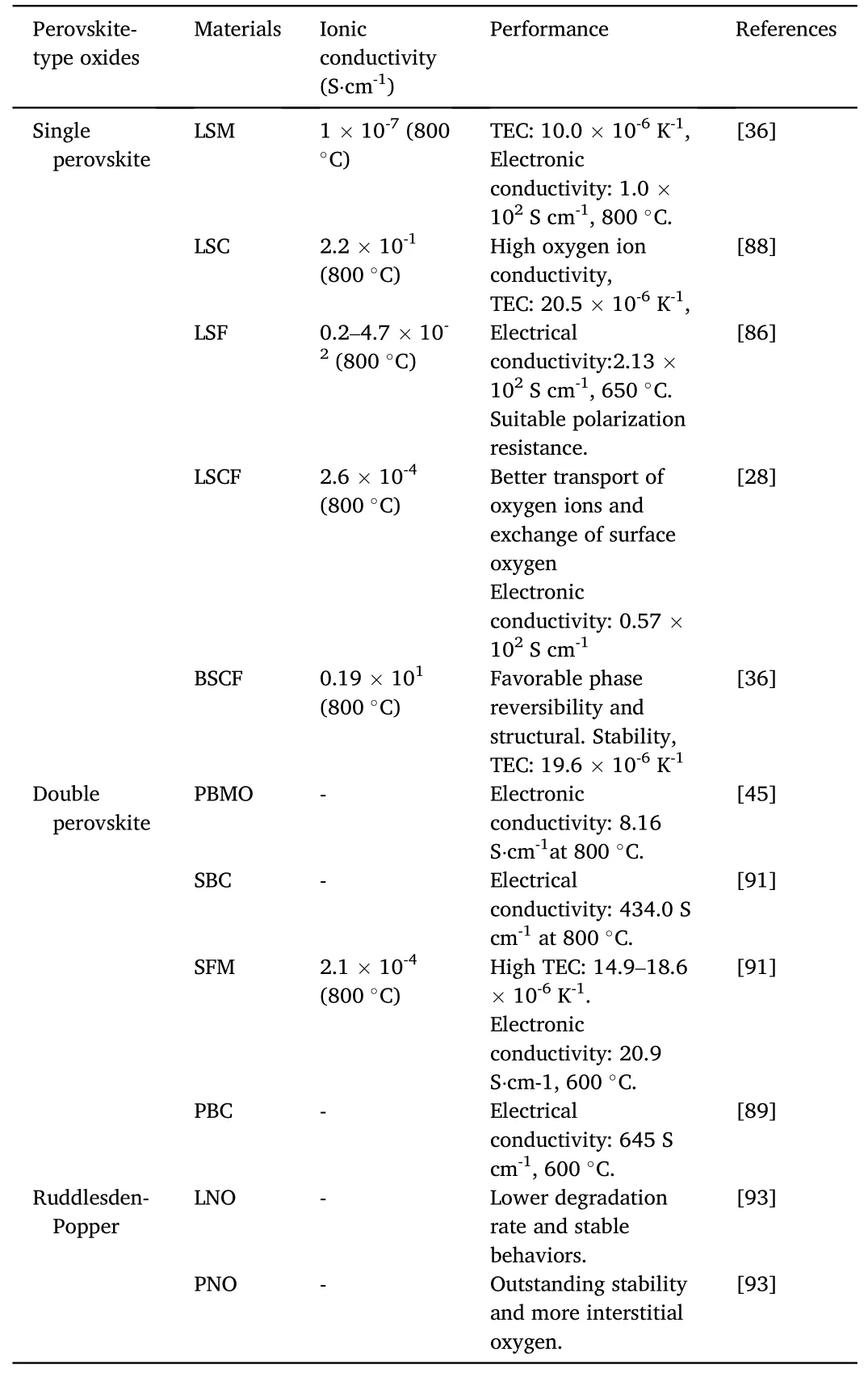
Table 3 Electrochemical performance parameters of different types of perovskite oxides.
3.1.Cermet type
Among most cermet hydrogen electrode materials,Ni-Y0.08Zr0.92O2+δ(Ni-YSZ) [63] has been widely used as a composite electrode material.However,impurities and inclusions in Ni particles or changes and coarsening of Ni particle morphology can lead to some irreversible deterioration of the SOEC in high current-density working environments.Hauch et al.[64] effectively addressed the problems of Ni-YSZ electrodes by optimizing the electrode structure.This was achieved by reducing the particle size,maximizing the density of the Ni-YSZ electrode to close to 100%, and selecting appropriate experimental conditions based on the electrode overpotential [65].In terms of improving conductivity, Liu et al.[66] formed a Cu-Ni-YSZ composite electrode by combining Cu with a Ni-YSZ electrode.As Cu has catalytic inertness, the electrode exhibited excellent resistance to carbon deposition and good conductivity.
Faced with the challenge of long-term stability of Ni/YSZ,the fluorite material CeO2-based oxides do not respond to Ni or YSZ and have certain oxygen vacancy defects and oxygen storage capabilities [67,68].Additionally, they can mitigate degradation and deactivation at high temperatures, making them a promising additive [68].Studies have found that adding cerium-based materials to traditional Ni/YSZ electrodes can increase hydrogen evolution and catalytic activity, and the two-phase boundary position(2 PBs) on the electrode can provide high power density even without metal catalysts[69,70].In the study by Chen et al.[67], CeO2nanoparticles were infiltrated into Ni/YSZ electrodes using a hexane solution.As depicted in Fig.4, the high viscosity facilitated the penetration of Ni-doped CeO2nanoparticles throughout the electrode volume, reaching the YSZ interface and filling microcracks between Ni and YSZ particles [70].The infiltrated hydrogen electrode effectively restored the electrocatalytic reaction zone, and enhance its electrochemical property to some extent.
In addition, for precious metal electrode materials, the adhesion to the electrolysis cell interface is weak and they are easily corroded, and the prices of precious metals are expensive.Therefore,they are limited to using metal catalysts to improve electrode performance [71].Most precious metal composite materials,mainly consisting of Pt and Ag[72],and are rarely used in practical production applications.Tao et al.[72]tested the Pt-YSZ metal ceramic electrode composition of the SOEC and demonstrated its contribution to the catalytic property of SOEC in high-temperature electrolysis [73].However, compared with Ni-YSZ,Pt-YSZ has a greater polarization resistance and is difficult to be applied in practical applications.
3.2.Metal oxide type
La0.75Sr0.25Cr0.5Mn0.5O3-δ(LSCM) is a highly promising material[74].As the Mn doping level of LSCM exceeds the infiltration level(33%),it exhibits comparable properties to Ni-YSZ in H2.Tao and Irvine developed the novel material over a decade ago to replace the Ni-YSZ oxygen electrode in SOFCs.Since then, abundant work has been ongoing to optimize LSCM,and it has now been developed as a hydrogen electrode material for SOECs [65,75].In detail, LSCM has good redox properties while its electronic conductivity and catalytic activity are not ideal.Metal phase composites are typically used to improve material properties.Li et al.[76] employed an impregnation method [77] to incorporate Ni metal into the LSCM framework, and this approach was adopted due to the favorable electrical catalytic property exhibited by metal elements.However,controlling metal catalysts on the substrate is problematic [78], and long-term work can lead to catalyst aggregation.To address this issue, Ruan et al.[79] impregnated Fe2O3onto the LSCM-SDC electrode for electrolysis [80,81], Fe2O3is reduced to Fe catalyst before electrolysis,and a 75%electrolysis conversion rate can be achieved in a composite hydrogen electrode electrolysis cell at 800°C.
La0.7Sr0.3VO3(LSV) [82] possesses unique properties as a hydrogen electrode, which can exhibit n-type conductivity in a hydrogen environment.Additionally, LSV also has certain catalytic properties in H2S,making it an excellent sulfur-resistant electrode material[83].However,the catalytic activity of LSV electrode is insufficient,limiting its properties.Li et al.[76]have incorporated nano-metallic elements into the LSV electrode.The introduction of metal catalysts(Ni,Fe,Pt,etc.)can greatly improve gas conversion rate and electrolysis efficiency, thus enhancing catalytic activity.It was found in SOEC-based hydrogen electrode steam electrolysis experiments that impregnation of Ni and Fe into the LSV electrode resulted in higher current density and about 20% increase in Faraday electrolysis efficiency compared to the LSV alone[76].
Therefore,the catalytic activity of electrode materials is an important factor affecting SOEC.Different materials have diverse catalytic properties.To further study SOEC electrodes and design better electrode materials, Table 4 summarizes some properties and parameters of representative SOEC electrode materials.
4.Electrode optimization strategy
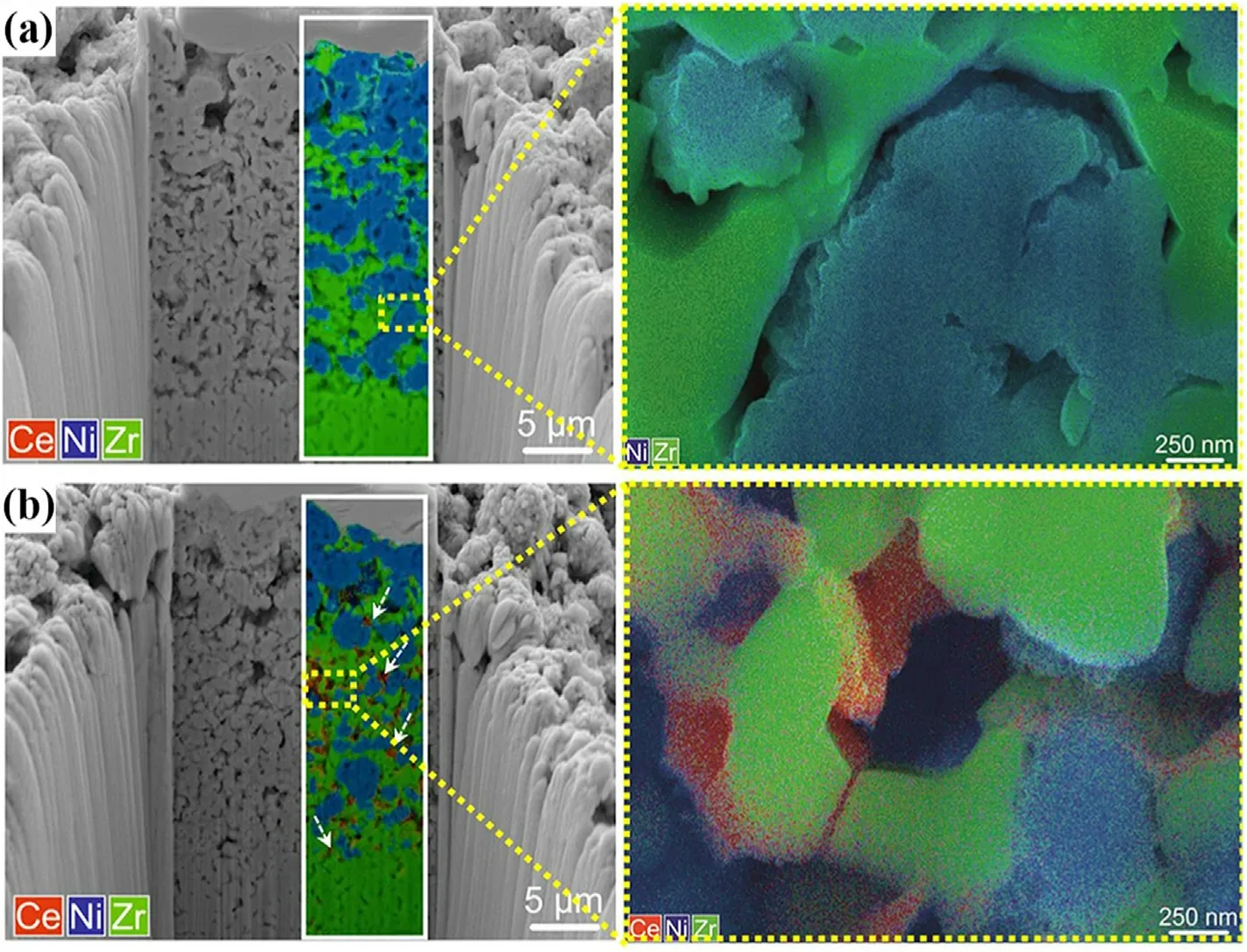
Fig.4.Cross-sectional FIB/SEM images with EDX-mapping of (a) Ni/YSZ and (b) NiCe@NiYSZ cathodes measured after several hours of electrolysis.Highmagnification images of selected electrode areas are included [67].
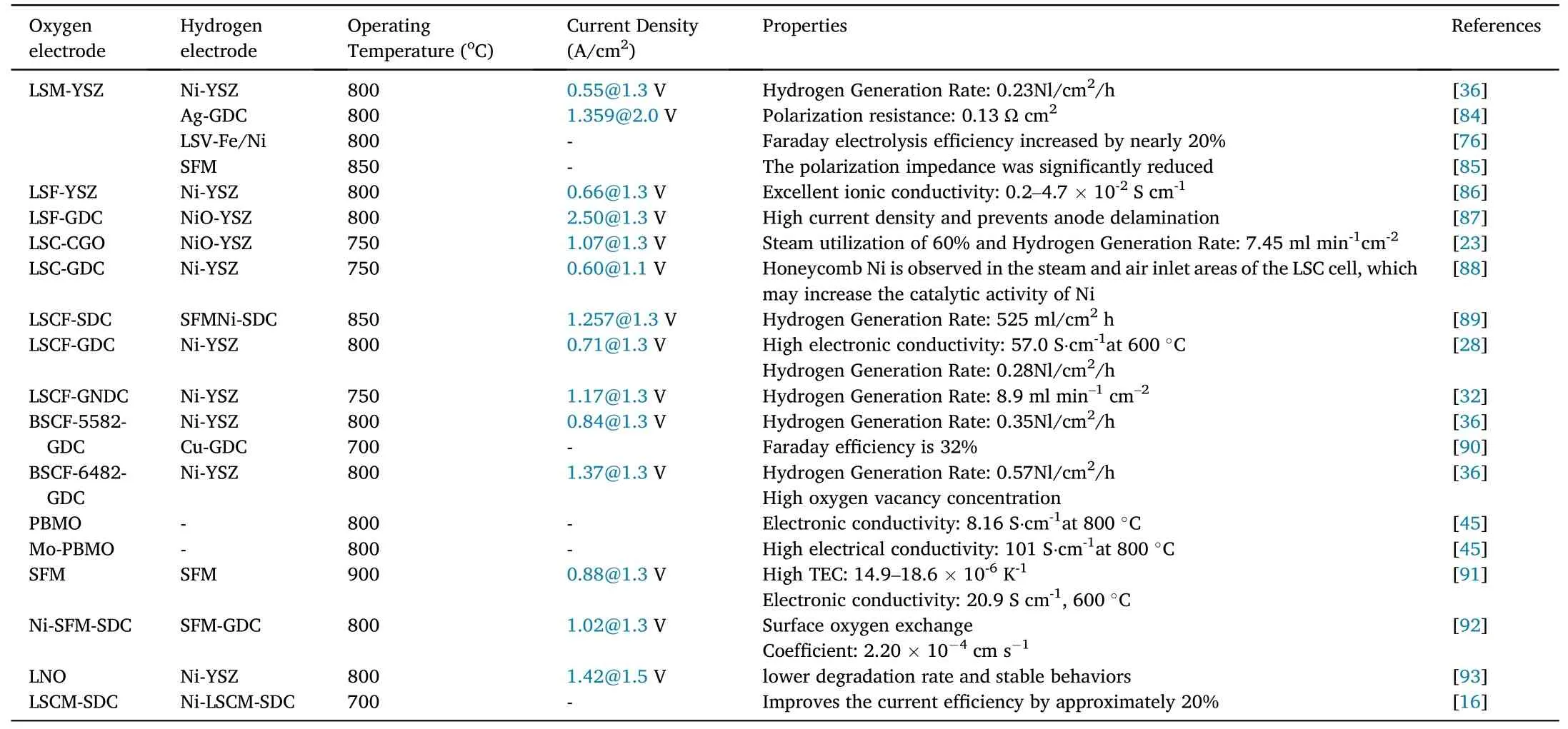
Table 4 Representative electrochemical property parameters in SOEC.
There are still problems with poor stability, suboptimal properties,and electrode degradation in SOEC electrode materials.The catalytic activity and stability of electrode materials will be key factors [94].Researchers are continuously exploring the optimization of electrodes,which mainly includes the optimization of structures and the improvement of electrode properties through doping ion conductors and extending the lifespan of electrode materials [95], Currently, some breakthroughs have been achieved.
4.1.Structure optimization
The structure of electrode materials is an essential factor in enhancing the properties of SOEC.The optimization of electrode structure mainly involves two aspects:one is the structure of gas transport,and the other is the structure of electrochemical reactions.
4.1.1.Structure of gas transport
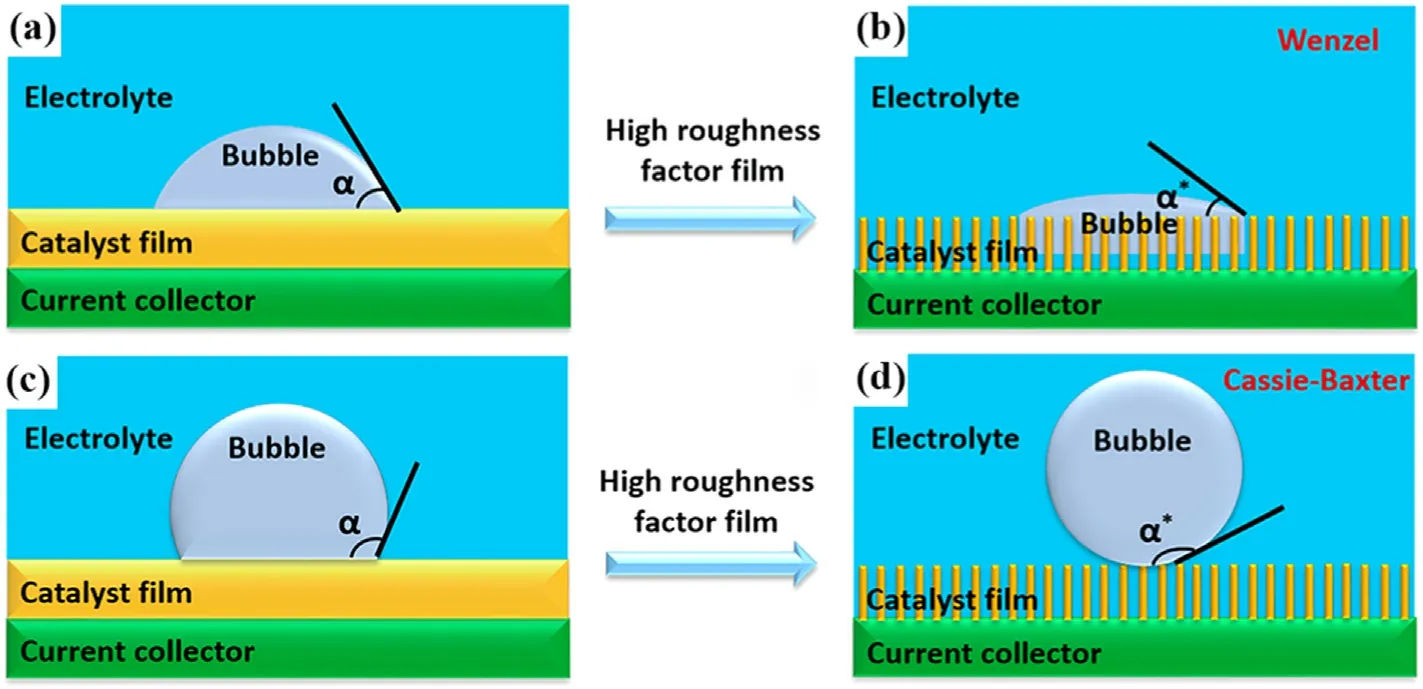
Fig.5.Schematic illustration of how the surface roughness affecting the bubble contact angle at given intrinsic aerophilicity: (a) flat aerophilic surface, (b) rough aerophilic surface, (c) flat aerophilic surface, and (d) rough aerophilic surface [98].
Due to the generation of gases,active sites can be covered and hinder the transfer of electrons and ions,increasing the mass transfer resistance,so it is necessary to improve gas transport, reduce diffusion resistance,and optimize gas mass transfer on the electrode material surface [96].Nanoarray structure electrodes with super-wettability have been constructed and demonstrated to have excellent properties in gas transport [97].As shown in Fig.5, Xu et al.[98] discovered that the high roughness of nanoarray structures is a key factor in constructing super-wetting electrodes when studying the potential impact of surface structure.Xu et al.used various strategies (hydrothermal reaction, and high-temperature gas-phase growth) to construct superhydrophobic electrodes.They carried out gas evolution reactions on the electrodes with different catalysts using different methods.Analysis showed that compared with traditional drop-casting-prepared planar electrodes, the superhydrophobic electrodes had lower adhesion to gas products,which facilitated gas evolution and made the reaction current stable [99].Moreover, the electrodes could improve the OER by promoting gas diffusion and electron transfer [98].Therefore, superhydrophobic electrodes are an essential method for solving the gas transport problem in electrode reactions.
4.1.2.Structure of electrochemical reaction
Researchers have constructed nanostructured perovskite/metal composite materials using a customized dissolution method[100].During the reaction,the catalyst is typically incorporated into the host lattice as a cation and the metal catalyst dissolves in the form of NPs during reduction.Compared to conventional techniques, this strategy can produce finer and more uniformly distributed nano-catalysts in the same amount of time.The dissolution of Ni NPs in La1-xSrCr0.9NiO3-δcan enhance the OER activity of Ni in perovskite,but the segregation of SrO can lead to structural instability[100].Previous studies have found that at high doping levels of Ru, Ru nanoparticles (NPs) can dissociate from the main lattice.The phenomenon of out-diffusion has been observed in these oxides with an A/B=1,but it is limited to a finite number of easily reducible cations that can out-diffuse as metal NPs.Non-stoichiometric perovskites with A/B >1 result in more severe A-site cation segregation due to the formation of non-stoichiometric perovskites.Therefore,a new strategy of using non-stoichiometric perovskites with A/B <1 has been proposed to mitigate A-site cation segregation,thereby reducing the instability of the perovskite structure.Neagu et al.[100] found that highly stable TiO2NPs could be generated by the dissolution of stable Ti atoms in the perovskite framework of LaSr0.4TiO3, which lacked A-site cations.These NPs were shown to enhance the stability and catalytic property of the perovskite electrode.Therefore, the utilization of A-site deficiency to produce NPs with higher stability and solubility in perovskite oxides is an essential method for improving the property of perovskite-type electrodes [101].
4.2.Property improvement of oxygen electrode through ion conduction
To address the issue of high electronic conductivity but low ionic conductivity in most oxygen electrode materials [53], adding ion conductors such as YSZ, GDC,and SDC (Ce1-xSmxO2-δ) to the electrode material can effectively enhance the electrode properties.For example,due to its low oxygen ion conductivity,LSM constrains the oxygen evolution reaction to occur predominantly at the interface between the SOEC oxygen electrode and electrolyte, leading to a significant polarization resistance for the oxygen electrode.Men et al.[102]have combined LSM with a cation conductor SDC-CuO (Ce0.85Sm0.15O2-δ-CuO) to form a composite material to improve the properties of LSM-based oxygen electrodes.Experimentally, they found that the Rp of LSM/SDC-CuO(0.89 Ω cm2) exhibited a significant reduction compared to LSM (1.73 Ω cm2)and LSM/SDC(1.35 Ω cm2)under conditions of 800°C and 40%RH [102].This also indicates that forming composite materials through ion conduction is an effective strategy to enhance oxygen electrode properties.
4.3.Optimization of electrode material lifespan
The degradation mechanism of the long-term stability of SOEC still remains problematic in high-temperature and high-humidity working environments.Therefore, the durability issue of electrode materials is a key factor for further development of SOEC.
The researchers took an alternative approach by skillfully altering the conditions of the high temperature of the electrolytic cell through a simple and scalable cathodic electrochemical deposition coating method called Cathodic Electrodeposition with Liquid Droplets (CELD) [103].Nanostructured deposits of SDC were uniformly coated onto porous Pt films to achieve stable composite electrodes at low temperatures.The CELD method creates a permeable and conductive SDC layer,which not only improves the electrode conductivity but also provides excellent thermal stability and durability.Even at high temperatures of 600°C,there is no degradation or deterioration observed, and the electrode conductivity remains high [103].
In addition,Zhao et al.utilized a phase separation method to prepare nickel-containing oxide nickel film electrodes coated with a carbon layer.The emphasis of the electrodes lies in their remarkable long-term cycling stability,with 93.8%capacitance retention after 5000 cycles[104].The superior rate performance and extended cycle life can be attributed to the unique structure of the film, the incorporation of nickel quantum dots,and the thin carbon coating [105].The excellent properties of this electrode can further advance the development of SOEC.
5.Summary and outlook
This article provides an overview of the most recent advancements in electrode materials SOEC, where oxygen electrodes are derived from single perovskite materials to generate oxygen electrode materials with better properties through doping or substitution, building nano- and porous structures, and other methods.Hydrogen electrodes are mainly ceramic composites and metal oxide materials based on Ni.Finally,based on the different characteristics of the materials,electrode material optimization strategies are introduced, including gas transport and electrochemical reaction optimization, as well as the combination of ion conductors and composite materials.
The classification of electrode materials for SOEC is extremely wide,and traditional electrode materials can exhibit excellent chemical properties through optimization and control of their microstructure.However, there are still some problems and challenges with electrode materials:
(1) Currently, research on electrode materials mainly focuses on doping of single perovskite materials such as Mn, Fe, and corresponding inherent issues of these materials need to be addressed(such as the delamination of LSM electrodes and the segregation of Sr elements).Meanwhile, double perovskite and R-P type perovskite, which have relatively complex structures and great potential as electrode materials, should be the focus of future research.
(2) As the two main methods for preparing NP-decorated perovskite,thermal reduction and electrochemical conversion both require high-temperature conditions.Therefore,it is essential to develop a strategy which can trigger the catalytic property of atoms to dissolve at low temperatures,while also exploring other methods for NP dissolution.
(3) Nanoscale perovskite catalysts can only provide limited electrochemical stability and tend to sinter at operating temperatures between 500 and 800°C, which can cause degradation of the nanostructured electrodes in long-term operation.Therefore,it is essential to evaluate the stability of the catalysts through in-situ characterization techniques or non-in-situ characterization before and after testing.
(4) The durability of electrode materials is the primary problem that needs to be addressed in SOEC.Especially, aging is accelerated during system start and stop.Therefore,it is necessary to explore the durability properties of materials during the electrolysis process and prolong the service life of SOEC electrodes.
Declaration of competing interest
The authors declare no competing financial interest.
Acknowledgments
This work was supported by the Outstanding Youth Foundation of Jiangsu Province of China (No.BK20211548) and the Yangzhou City-Yangzhou University Cooperation Foundation(No.YZ2021153).
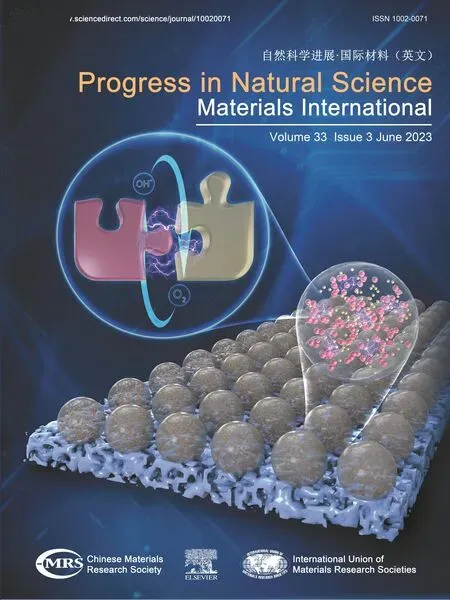 Progress in Natural Science:Materials International2023年3期
Progress in Natural Science:Materials International2023年3期
- Progress in Natural Science:Materials International的其它文章
- Research progress of composite cathode materials for Solid oxide fuel cells
- A review on solidification of alloys under hypergravity
- Improving mechanical properties of Mg-Sn alloys by co-addition of Li and Al
- Multi-stimuli bilayer hydrogel actuator for remotely controllable transportation of droplets
- The formation and temperature stability of microemulsion emulsified by polyoxyethylene ether surfactant
- Towards high-efficiency of hydrogen purification in metal hydride
